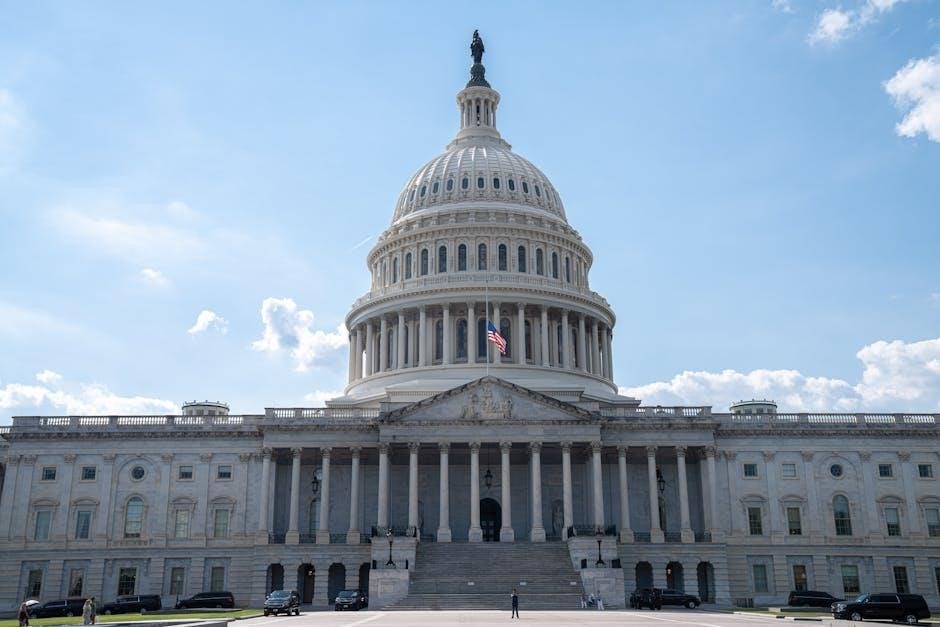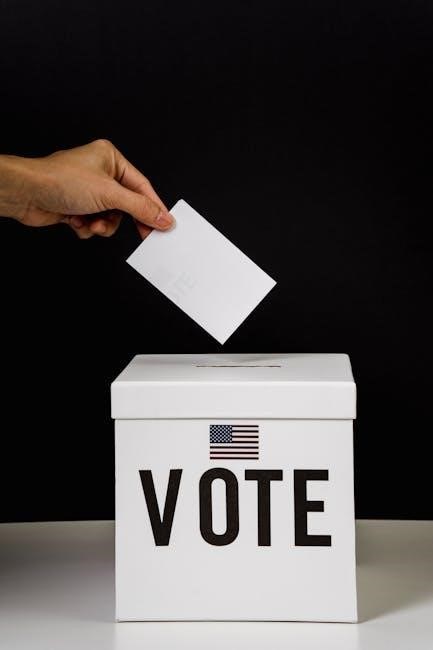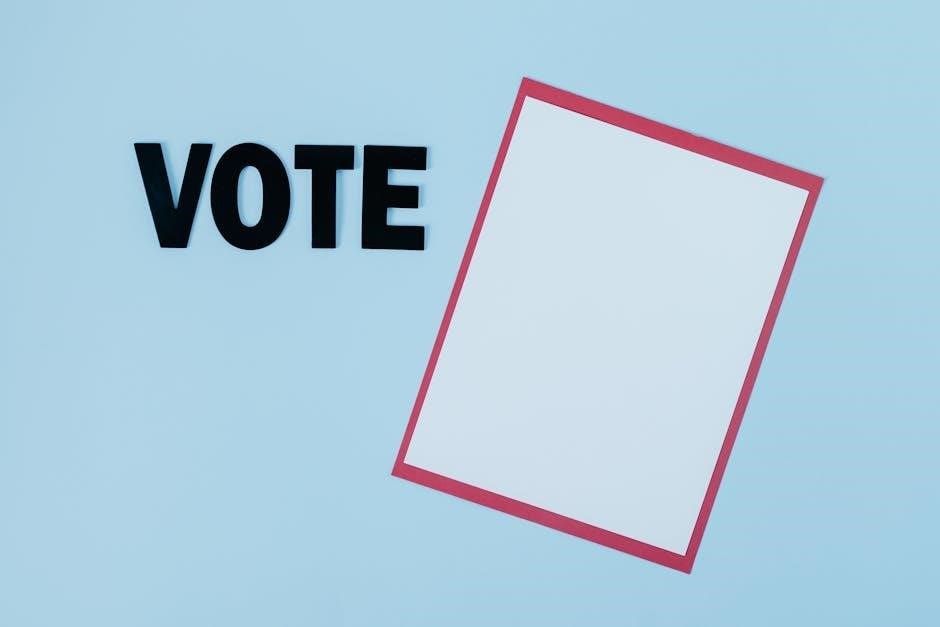
American Government: Roots and Reform provides a comprehensive overview of the U.S. political system, tracing its historical development and evolution. This resource, available in PDF and other formats, offers insights into foundational principles, key reforms, and modern challenges, equipping students to understand the complexities of governance and its relevance to contemporary issues.
1.1 Overview of the Book and Its Significance
American Government: Roots and Reform by Karen O’Connor and Larry Sabato explores the historical and modern dynamics of U.S; governance. First published in 2011, it has been updated in editions like the 2016 and 2020 Presidential Election Editions. The book provides a detailed analysis of the foundations of American government, tracing its evolution through key reforms and contemporary challenges. It emphasizes the interconnectedness of historical events and current political issues, offering students a holistic understanding of the system. Available in formats like PDF, ePub, and MOBI, it remains a vital resource for studying U.S. politics and its enduring principles.
1.2 Historical Context and Modern Relevance
American Government: Roots and Reform emphasizes the importance of understanding the historical foundations of U.S. governance to address modern challenges. By examining over 250 years of political development, the book connects past events, such as the debate over healthcare reform in 2010, to contemporary policy-making. This approach highlights how historical principles continue to shape current laws and societal expectations. The text underscores the relevance of historical context in navigating issues like federal power expansion and civil rights, making it a vital resource for grasping the evolution and ongoing adaptation of American democracy.

The Roots of American Government
The roots of American government trace back to colonial governance and the Revolutionary War, shaping foundational principles like democracy and federalism. This section explores early influences and their lasting impact on modern governance.
2.1 Colonial Era and the Foundations of Governance
The colonial era laid the groundwork for American governance, influenced by British traditions and the colonists’ desire for self-rule. Early governance structures, such as the Mayflower Compact and the House of Burgesses, introduced democratic practices. These institutions emphasized representation and consent, shaping the colonies’ political culture. The colonies’ experiences under British rule fostered a sense of autonomy and resistance, which later fueled the Revolution. This period established key principles, including local self-governance and the idea of limited government, which became cornerstones of the American political system and its eventual reforms. These foundations continue to influence modern governance and political thought.
2.2 The Revolutionary War and the Birth of Democracy
The Revolutionary War marked a pivotal shift, transitioning the colonies from British rule to self-governance. The Declaration of Independence, drafted in 1776, articulated foundational democratic principles, including liberty, equality, and consent of the governed. This document, influenced by Enlightenment ideas, became a cornerstone of American democracy. The war’s outcome established the United States as an independent nation, laying the groundwork for its political identity; The post-revolutionary period saw the adoption of the Articles of Confederation, an early attempt at unified governance, which, despite its limitations, set the stage for the eventual drafting of the Constitution and the birth of a robust democratic system.
2.3 The Articles of Confederation and Their Limitations
The Articles of Confederation, adopted in 1781, served as the first national government of the United States. However, their limitations soon became apparent. The absence of executive and judicial branches left decision-making solely to Congress, while the inability to levy taxes forced reliance on voluntary state contributions. Additionally, amendments required unanimous state approval, hindering necessary reforms. The lack of a unified authority led to economic struggles and interstate conflicts, ultimately rendering the Articles ineffective. These shortcomings underscored the need for a more robust system, paving the way for the Constitutional Convention of 1787 and the eventual adoption of the U.S. Constitution in 1789.
The Constitution and Its Principles
The Constitution establishes the framework of the U.S. government, emphasizing separation of powers, checks and balances, and individual rights. It ensures federal authority while respecting state sovereignty.
3.1 The Drafting of the Constitution
The drafting of the Constitution occurred during the Philadelphia Convention in 1787. Delegates debated representation, federal power, and individual rights, leading to the Great Compromise. The document, finalized in September, established a federal system with three branches. Its ratification in 1788 marked the birth of the U.S. government framework. The Constitution’s creation reflects a balance between unity and state autonomy, shaping the nation’s political structure. This foundational document has endured, guiding governance and reforms for over two centuries, ensuring stability and adaptability in an evolving society. Its principles remain central to American democracy and law.
3.2 The Bill of Rights and Individual Liberties
The Bill of Rights, comprising the first ten amendments to the Constitution, safeguards fundamental liberties such as free speech, religion, and the right to bear arms. Ratified in 1791, these amendments ensure individual freedoms and limit government overreach. The Fourteenth Amendment further reinforced these protections by applying due process at the state level. Landmark Supreme Court decisions have interpreted and expanded these rights, shaping modern civil liberties. The Bill of Rights remains a cornerstone of American democracy, protecting citizens’ autonomy and fostering a culture of freedom. Its enduring relevance underscores the importance of constitutional safeguards in a changing society.
3.3 The System of Checks and Balances
The system of checks and balances is a cornerstone of the U.S. Constitution, designed to prevent any one branch of government from becoming too powerful. The legislative, executive, and judicial branches each have distinct powers and responsibilities. Congress can impeach the president, while the president can veto legislation. The judiciary, through judicial review, can declare laws unconstitutional. This balance ensures accountability and prevents abuses of power. The system fosters collaboration while maintaining separation, safeguarding individual liberties and promoting governance that aligns with the public interest. It remains a vital mechanism for maintaining democracy and constitutional integrity in the United States.

The Evolution of American Government
The evolution of American government reflects transformative periods, from the Progressive Era to the New Deal, civil rights legislation, and technological advancements shaping modern governance.
4.1 The Progressive Era and Government Reform
The Progressive Era (1890–1920) sought to address corruption, inequality, and inefficiency in government. Reformers pushed for direct primaries, referendums, and recalls to increase public participation. Leaders like Theodore Roosevelt and Woodrow Wilson championed trust-busting, consumer protection, and labor rights. The 16th Amendment enabled federal income tax, while the 17th established direct Senate elections. These reforms aimed to restore public trust and create a more responsive government, laying the groundwork for modern regulatory frameworks and social policies. The era’s emphasis on transparency and accountability continues to influence contemporary governance and political discourse.
4.2 The New Deal and Expansion of Federal Power
The New Deal, launched by President Franklin D. Roosevelt during the Great Depression, revolutionized federal authority. Programs like the Works Progress Administration and Social Security Administration established unprecedented government intervention in the economy. The expansion of federal power aimed to alleviate suffering and stimulate recovery. This era marked a shift from laissez-faire policies to active federal involvement, reshaping the relationship between government and citizens. The New Deal’s legacy is evident in modern social safety nets and regulatory frameworks, demonstrating how crisis can drive significant reforms and redefine the role of government in society.
4.3 Civil Rights Legislation and Social Change
The Civil Rights Act of 1964 and the Voting Rights Act of 1965 marked pivotal moments in American history, dismantling segregation and ensuring voting rights for African Americans. These laws, championed by leaders like Martin Luther King Jr., reflected a broader movement for racial equality. The legislation not only addressed systemic discrimination but also inspired future social reforms, including gender equality and disability rights. By transforming legal frameworks, these acts laid the groundwork for a more inclusive society, demonstrating how government action can drive profound social change and uphold democratic ideals. Their impact remains central to ongoing struggles for justice today.

The Role of the Supreme Court
The Supreme Court plays a pivotal role in interpreting laws, ensuring constitutional adherence, and resolving federal disputes. Its decisions shape legal precedent and safeguard individual rights, influencing the nation’s legal and democratic framework.
5.1 Landmark Supreme Court Decisions
Landmark Supreme Court decisions have profoundly shaped American law and society. Cases such as Brown v. Board of Education (1954) dismantled racial segregation, while Roe v. Wade (1973) redefined abortion rights. Miranda v. Arizona (1966) established protections for criminal defendants, and Marbury v. Madison (1803) affirmed judicial review. These rulings reflect the Court’s role in interpreting the Constitution and resolving societal conflicts. They underscore the judiciary’s power to balance individual liberties with governmental authority, ensuring the Constitution remains a living document responsive to evolving values and challenges in American democracy.
5.2 Judicial Activism vs. Judicial Restraint
Judicial activism and judicial restraint represent contrasting approaches to judicial decision-making. Judicial activism involves judges taking an active role in shaping the law, often overturning precedent or legislating from the bench. In contrast, judicial restraint emphasizes deferring to the legislature and avoiding judicial overreach. The debate between these philosophies is central to discussions about the Supreme Court’s role. Critics argue that activism risks undermining democratic processes, while supporters of restraint worry about failing to address injustices. These differing approaches significantly influence landmark rulings, particularly in areas like civil rights, federal power, and individual liberties, shaping the balance of power in American governance.

The Legislative Process
The legislative process involves introducing bills, committee reviews, debates, and voting in both chambers; It ensures representation of diverse interests while shaping public policy effectively.
6.1 How Laws Are Made
The legislative process begins with the introduction of a bill by a member of Congress. The bill is then referred to a committee for review, where it may be amended or rejected. If approved, the bill moves to the full chamber for debate and voting. Both the House and Senate must pass the bill in identical form before it is sent to the President for signature. This collaborative process ensures that laws reflect diverse interests while maintaining constitutional integrity.
6.2 The Role of Lobbying in Legislation
Lobbying plays a significant role in shaping legislation by influencing policymakers on behalf of special interest groups. Lobbyists, representing various organizations, advocate for specific policies by providing data, testifying before committees, and advising lawmakers. While lobbying can ensure diverse voices are heard, it also raises concerns about unequal influence and potential corruption. Ethical regulations aim to balance advocacy and transparency, ensuring fair representation in the legislative process. This dynamic highlights the tension between public and private interests in American governance, as outlined in American Government: Roots and Reform.

The Executive Branch
The Executive Branch, led by the President, executes laws, commands the military, and conducts foreign policy. It includes the Vice President and various executive departments.
7.1 The Evolution of the Presidency
The presidency has evolved significantly since its inception, shaped by historical events and shifting societal demands. From George Washington’s establishment of presidential precedent to modern-day leadership, the role has expanded in power and influence. Key milestones include the Great Depression, World War II, and the Civil Rights era, which redefined executive authority. Contemporary challenges, such as political polarization and technological advancements, continue to reshape the presidency. This evolution reflects the dynamic nature of American governance, balancing tradition with the need for adaptability in addressing new complexities and retaining public trust.
7.2 The Role of the Executive Branch in Modern Government
The Executive Branch, led by the President, plays a central role in modern governance, executing laws and setting policy agendas. It oversees federal agencies, enforces regulations, and commands the military. The President also engages in diplomacy, shaping international relations. Challenges such as political polarization and technological advancements require the Executive Branch to adapt swiftly. Collaboration with Congress and the judiciary ensures a balanced system, while addressing contemporary issues like healthcare, climate change, and economic reform remains critical. The Executive Branch’s effectiveness hinges on its ability to respond to evolving societal needs while upholding constitutional principles and fostering public trust.

State and Local Governance
State and local governments play a vital role in implementing federal policies and addressing regional needs. Federalism ensures a division of powers, allowing states to manage education, transportation, and public safety while adhering to national standards. Local governments, such as counties and municipalities, handle zoning, law enforcement, and public services. The balance between state and federal authority continues to evolve, adapting to modern challenges like infrastructure, healthcare, and environmental regulation. Collaboration and conflict between these levels of governance shape the effectiveness of public policy and service delivery.
8.1 Federalism and the Division of Powers
Federalism divides governmental authority between national and state levels, ensuring a balance of power. The U.S. Constitution outlines this framework, granting the federal government authority over foreign policy, defense, and interstate commerce, while states manage education, transportation, and public safety. This division allows for tailored local policies while maintaining national unity. The system adapts to modern challenges, such as healthcare and environmental regulation, through cooperative federalism. This structure fosters innovation at the state level and ensures accountability, as both levels of government remain responsive to their constituents. Federalism’s flexibility has been key to addressing evolving societal needs and maintaining democratic stability.
8.2 The Relationship Between State and Federal Governments
The relationship between state and federal governments is defined by cooperation and tension. States collaborate with the federal government on policies like healthcare and education, sharing funding and responsibilities. However, debates over state sovereignty versus federal authority persist, particularly in areas like civil rights and environmental regulation. Historical tensions, such as the balance of power during the Civil Rights era, highlight this dynamic. Modern challenges, including healthcare reform and immigration, further test this relationship. Despite these conflicts, the system maintains a balance, ensuring state autonomy while upholding national standards and addressing collective needs through shared governance and legal frameworks. This duality remains central to U.S. governance.

Voting Rights and Electoral Reform
This chapter explores the expansion of voting rights and contemporary issues in electoral reform. It examines historical milestones, challenges, and ongoing efforts to ensure equitable access to the ballot box, reflecting the evolution of American democracy and its commitment to representative governance.
9.1 The Expansion of Voting Rights
The expansion of voting rights in the U.S. has been a cornerstone of democratic progress. From the 15th Amendment granting African American men the right to vote after the Civil War to the 19th Amendment extending suffrage to women in 1920, these milestones reflect the ongoing struggle for equality. The Voting Rights Act of 1965 further dismantled racial barriers, while the 26th Amendment lowered the voting age to 18 in 1971. Modern efforts continue to address voter suppression, gerrymandering, and access issues, ensuring all citizens can participate in shaping the nation’s future.
9.2 Contemporary Issues in Electoral Reform
Contemporary electoral reform debates focus on ensuring fair and accessible elections. The 2020 presidential election highlighted issues of voter access, mail-in voting, and election integrity. Ongoing discussions include voter ID laws, gerrymandering, and the impact of technology on voting systems. Efforts to modernize election infrastructure and address partisan redistricting aim to enhance representation and public trust. Additionally, concerns about foreign interference and misinformation underscore the need for robust security measures. Reform initiatives seek to balance accessibility with integrity, ensuring all eligible citizens can participate in shaping the nation’s future through secure and equitable electoral processes.

Public Opinion and Media Influence
Public opinion significantly shapes policy decisions, reflecting societal values and priorities. Media plays a crucial role in influencing these perceptions, impacting governance and political dynamics.
10.1 The Role of Public Opinion in Shaping Policy
Public opinion serves as a cornerstone for policymaking, reflecting the collective will and priorities of citizens. Elected officials often align their decisions with popular sentiment to maintain support. Surveys, polls, and media coverage gauge public attitudes, influencing legislative agendas and executive actions. For instance, shifts in public opinion on issues like healthcare or climate change have prompted significant policy reforms. This dynamic ensures that governance remains responsive to societal needs, embedding democratic principles into the policymaking process. Understanding public opinion’s role is essential for analyzing how policies evolve and adapt over time.
10.2 Media Influence on Government and Politics
The media plays a pivotal role in shaping government and political landscapes by disseminating information and framing public discourse. Through various platforms, it influences public opinion, holds officials accountable, and sets political agendas. In the digital age, social media has amplified this impact, enabling rapid dissemination of news and fostering direct engagement between citizens and policymakers. However, concerns about bias and misinformation highlight the need for a balanced approach. The interplay between media, politics, and public perception remains a critical factor in modern governance, underscoring the importance of a free and responsible press in a democratic society.

Future Challenges and Reforms
American government faces challenges like political polarization, technological advancements, and global shifts. Reforms may include electoral system changes, campaign finance laws, and enhancing legislative efficiency to address these issues.
11.1 Addressing Political Polarization
Political polarization poses a significant challenge to American governance, fostering division and gridlock. This phenomenon, rooted in ideological extremes, has intensified over decades, eroding bipartisan cooperation. To address this, reforms such as campaign finance regulation, redistricting changes, and media literacy initiatives are proposed. Encouraging civic engagement and fostering dialogue across party lines can help mitigate polarization. Understanding its historical and contemporary drivers is essential for developing effective solutions to restore unity and functionality in government. Addressing polarization requires systemic reforms and a collective commitment to bridging divides for the sake of democratic stability and progress.
11.2 The Impact of Technology on Governance
Technology has profoundly shaped modern governance, enhancing transparency, accessibility, and efficiency. Digital platforms enable citizens to engage with government processes, fostering participatory democracy; However, challenges such as cybersecurity threats, data privacy concerns, and misinformation loom large. The integration of artificial intelligence and big data in policy-making raises ethical questions about bias and accountability. Balancing innovation with safeguards is crucial to ensure technology strengthens, rather than undermines, democratic institutions. By addressing these complexities, technology can continue to be a transformative force in improving governance and public trust in the digital age.



